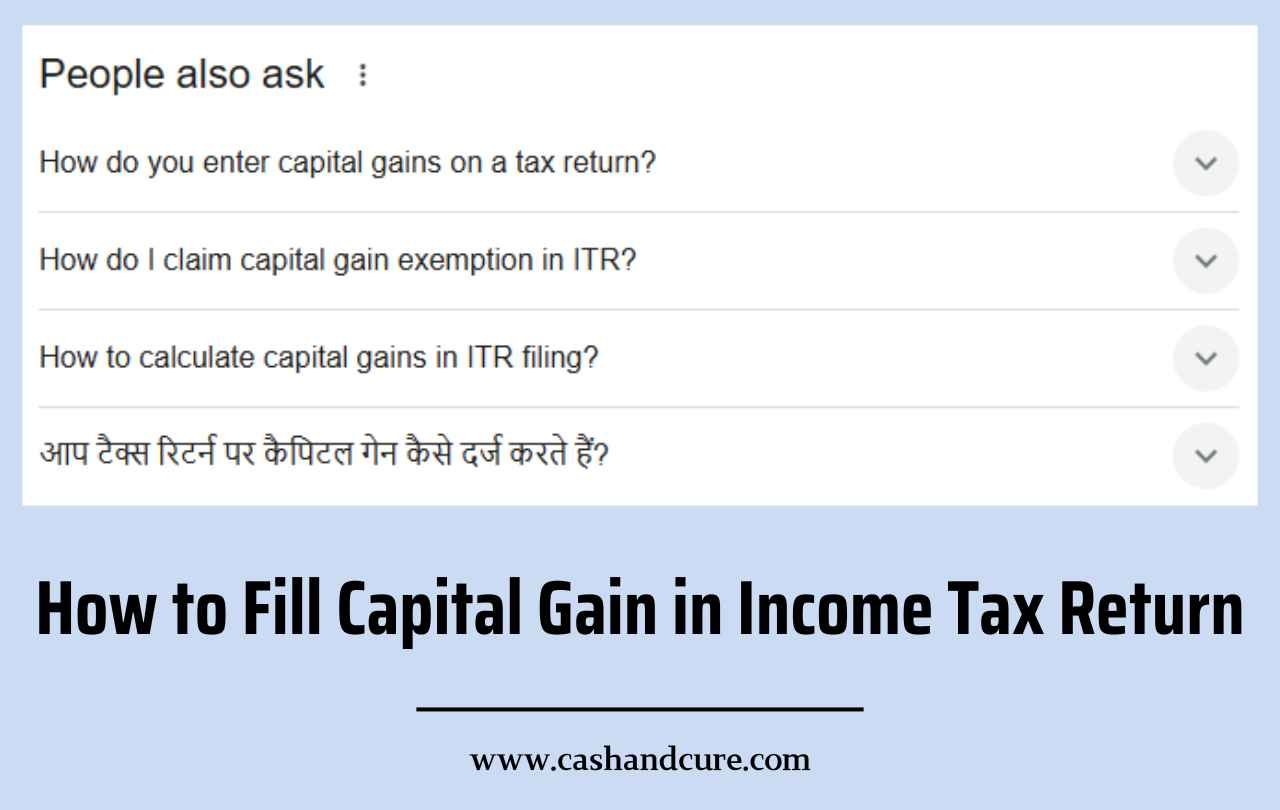Filing your income tax return can be a bit tricky, especially when it comes to going through capital gains. Capital gains are profits earned from the sale of assets such as stocks, property, or mutual funds. It is very important to report these gains correctly to avoid penalties and ensure compliance with the law. We will organize the steps to file capital gains statements in your income tax return, take a look at unlisted companies under the Income Tax Act, and give a detailed income tax calculation guide.
How to Fill Capital Gain in Income Tax Return
Capital gains are divided into two categories:
- Short-Term Capital Gains (STCG): Gains on assets held for less than a specified period (e.g., less than 12 months for stocks).
- Long-Term Capital Gains (LTCG): Gains on assets held for a longer period (e.g., more than 12 months for stocks).
Step-by-Step Guide:
- Determine the Type of Capital Gain:
- Identify whether the asset falls under STCG or LTCG based on the holding period.
- Collect Necessary Documents:
- Sale deed or transaction statement.
- Purchase deed or acquisition details.
- Cost of improvement, if any.
- Calculate the Gains:
- STCG: Sale Price – (Purchase Price + Cost of Improvement + Transfer Charges).
- LTCG: Sale Price – (Indexed Cost of Acquisition + Indexed Cost of Improvement + Transfer Charges).
- Select the Correct ITR Form:
- Use ITR-2 for individuals with capital gains but no business income.
- Use ITR-3 if you have business income along with capital gains.
- Fill in the Details:
- Report capital gain details in Schedule CG of the ITR form.
- Mention sale value, purchase cost, and indexed cost (if applicable).
- Claim Exemptions:
- Use Sections like 54 (residential property reinvestment) or 54EC (investment in specified bonds) to claim exemptions.
- Submit and Verify:
- After filling out the details, submit the form online and verify it using Aadhaar OTP, net banking, or a physical acknowledgment slip.
Unlisted Company as Per Income Tax Act
An unlisted company is a private company whose shares are not traded on a recognized stock exchange. The Income Tax Act provides specific guidelines for taxation of income related to unlisted companies, which include:
- Taxation of Dividends:
- Dividends received from unlisted companies are taxable in the hands of the shareholder under the “Income from Other Sources” category.
- Capital Gains on Share Transfer:
- Salee of shares of an unlisted company attracts capital gains tax. The holding period for determining LTCG is 24 months or more.
- Valuation of Shares:
- As per Section 56(2viiiib), shares issued by an unlisted company above fair market value are taxable as income in the hands of the company.
- Angel Tax:
- Startups receiving investments above the fair market value may be subject to angel tax unless they meet specified exemptions.
- Tax Deductions:
- Investments in eligible startups or small businesses can qualify for deductions under Section 80C or other sections.
Reporting in ITR:
- Mention income from dividends under “Income from Other Sources.”
- Capital gains on unlisted shares must be reported in Schedule CG.
Income Tax Calculation Statement
Preparing an accurate income tax calculation statement is essential for ensuring correct tax liability. How to calculate your income tax:
Components of the Statement:
- Income from Various Sources:
- Include salary, house property, business income, capital gains, and other sources like interest and dividends.
- Deductions and Exemptions:
- Claim eligible deductions under Section 80C (e.g., investments in PPF, ELSS, or life insurance), 80D (medical insurance), and others.
- Gross Total Income (GTI):
- Add all income sources and subtract exemptions.
- Net Taxable Income:
- Subtract deductions from GTI to get the taxable income.
- Tax Calculation:
- Apply the applicable tax rates based on the chosen regime (new or old).
- Add Surcharge and Cess:
- Include a surcharge (if applicable) and a 4% health and education cess.
- TDS and Advance Tax:
- Subtract TDS and advance tax already paid to calculate the final tax payable or refund.
Example Calculation:
| Income Source | Amount (Rs.) |
|---|---|
| Salary | 10,00,000 |
| Capital Gains | 2,00,000 |
| Other Income | 50,000 |
| Gross Total Income | 12,50,000 |
| Deductions (80C, 80D) | 1,50,000 |
| Net Taxable Income | 11,00,000 |
| Tax Liability | 1,32,500 |
| TDS/Advance Tax Paid | 1,20,000 |
| Tax Payable | 12,500 |
FAQs: How to Fill Capital Gain in Income Tax Return
The holding period for long-term capital gains on unlisted shares is 24 months or more.
Yes, you can claim exemptions under Sections 54, 54F, or 54EC by reinvesting the gains in specified assets or bonds.
Yes, dividends are taxable under “Income from Other Sources.
Failure to report capital gains can result in penalties, interest, or legal action by the Income Tax Department.
Multiply the original purchase price by the cost inflation index (CII) of the sale year divided by the CII of the purchase year.


Leave a Reply
You must be logged in to post a comment.